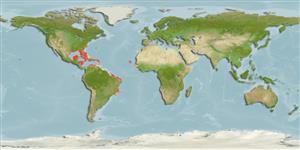Teleostei (teleosts) >
Anguilliformes (Eels and morays) >
Muraenidae (Moray eels) > Uropterygiinae
Etymology: Anarchias: Greek, anarchia, -as = without a chief, lack of authority (Ref. 45335).
Environment: milieu / climate zone / depth range / distribution range
Ecology
Marine; reef-associated; depth range 0 - 200 m (Ref. 5951). Tropical; 43°N - 24°S, 97°W - 9°E
Western Atlantic: Bermuda and southern Florida, USA (Ref. 7251) to southern Brazil (Ref. 26938). Eastern Atlantic: known only from Annobon Island, but likely to be present on other offshore islands in the Bay of Biafra (Ref. 4450). Northwest Atlantic: Canada (Ref. 5951).
Size / Weight / Age
Maturity: Lm ? range ? - ? cm
Max length : 20.0 cm TL male/unsexed; (Ref. 4450)
Small, varies from uniformly dark brown to blotched. Irregular pattern of pale marks on lower side of head and chin (Ref. 26938).
Occurs on shallow, poorly developed coral reefs to deep rocky slopes (Ref. 7251).
Life cycle and mating behavior
Maturity | Reproduction | Spawning | Eggs | Fecundity | Larvae
Robins, C.R., R.M. Bailey, C.E. Bond, J.R. Brooker, E.A. Lachner, R.N. Lea and W.B. Scott, 1991. Common and scientific names of fishes from the United States and Canada. Am. Fish. Soc. Spec. Publ. (20):183 p. (Ref. 3814)
IUCN Red List Status (Ref. 130435: Version 2024-1)
Threat to humans
Harmless
Human uses
Tools
Special reports
Download XML
Internet sources
Estimates based on models
Preferred temperature (Ref.
123201): 20 - 27.5, mean 24.8 °C (based on 196 cells).
Phylogenetic diversity index (Ref.
82804): PD
50 = 0.5005 [Uniqueness, from 0.5 = low to 2.0 = high].
Bayesian length-weight: a=0.00069 (0.00033 - 0.00146), b=3.12 (2.93 - 3.31), in cm total length, based on LWR estimates for this (Sub)family-body shape (Ref.
93245).
Trophic level (Ref.
69278): 3.4 ±0.5 se; based on size and trophs of closest relatives
Resilience (Ref.
120179): High, minimum population doubling time less than 15 months (Preliminary K or Fecundity.).
Fishing Vulnerability (Ref.
59153): Low vulnerability (10 of 100).
Nutrients (Ref.
124155): Calcium = 70.9 [39.1, 148.9] mg/100g; Iron = 0.63 [0.37, 1.20] mg/100g; Protein = 18.5 [16.2, 21.1] %; Omega3 = 0.162 [0.070, 0.501] g/100g; Selenium = 41.3 [21.3, 91.0] μg/100g; VitaminA = 111 [31, 369] μg/100g; Zinc = 1.24 [0.85, 1.76] mg/100g (wet weight);
